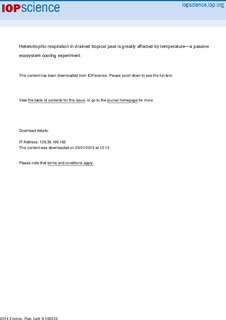| dc.contributor.author | Jauhiainen, Jyrki | |
| dc.contributor.author | Kerojoki, Otto | |
| dc.contributor.author | Silvennoinen, Hanna Marika | |
| dc.contributor.author | Limin, Suwido | |
| dc.contributor.author | Vasander, Harry | |
| dc.date.accessioned | 2015-01-20T12:14:04Z | |
| dc.date.accessioned | 2018-05-29T10:34:43Z | |
| dc.date.available | 2015-01-20T12:14:04Z | |
| dc.date.available | 2018-05-29T10:34:43Z | |
| dc.date.issued | 2014 | |
| dc.identifier.citation | Jauhiainen, J., Kerojoki, O., Silvennoinen, H., Limin, S., & Vasander, H. (2014). Heterotrophic respiration in drained tropical peat is greatly affected by temperature—a passive ecosystem cooling experiment. Environmental Research Letters, 9(10), 105013. | nb_NO |
| dc.identifier.issn | 1748-9326 | |
| dc.identifier.uri | http://hdl.handle.net/11250/2499554 | |
| dc.description.abstract | Vast areas of deforested tropical peatlands do not receive noteworthy shading by vegetation, which increases the amount of solar radiation reaching the peat surface. Peat temperature dynamics and heterotrophic carbon dioxide (CO2), nitrous oxide (N2O) and methane (CH4) fluxes were monitored under four shading conditions, i.e. unshaded, 28%, 51% and 90% shading at experiment sites established on reclaimed fallow agricultural- and degraded sites in Central Kalimantan, Indonesia. Groundwater tables on the sites were at about 50 cm depth, the sites were maintained vegetation free and root ingrowth to gas flux monitoring locations was prevented. Half of the four shading areas received NPK-fertilization 50 kg ha−1 for each of N, P and K during the experiment and the other half was unfertilized. Increases in shading created a lasting decrease in peat temperatures, and decreased diurnal temperature fluctuations, in comparison to less shaded plots. The largest peat temperature difference in the topmost 50 cm peat profile was between the unshaded and 90% shaded surface, where the average temperatures at 5 cm depth differed up to 3.7 °C, and diurnal temperatures at 5 cm depth varied up to 4.2 °C in the unshaded and 0.4 °C in the 90% shaded conditions. Highest impacts on the heterotrophic CO2 fluxes caused by the treatments were on agricultural land, where 90% shading from the full exposure resulted in a 33% lower CO2 emission average on the unfertilized plots and a 66% lower emission average on the fertilized plots. Correlation between peat temperature and CO2 flux suggested an approximately 8% (unfertilized) and 25% (fertilized) emissions change for each 1 °C temperature change at 5 cm depth on the agricultural land. CO2 flux responses to the treatments remained low on degraded peatland. Fertilized conditions negatively correlated with N2O efflux with increases in temperature, suggesting a 12–36% lower efflux for each 1 °C increase in peat temperature (at 5 cm depth) at the sites. Despite the apparently similar landscapes of fallow agricultural land and degraded peatland sites, the differences in greenhouse gas dynamics are expected to be an outcome of the long-term management differences. | nb_NO |
| dc.language.iso | eng | nb_NO |
| dc.rights | Navngivelse 4.0 Internasjonal | * |
| dc.rights.uri | http://creativecommons.org/licenses/by/4.0/deed.no | * |
| dc.subject | fertilization | nb_NO |
| dc.subject | greenhouse gases | nb_NO |
| dc.subject | land cover | nb_NO |
| dc.subject | land use | nb_NO |
| dc.subject | shading | nb_NO |
| dc.subject | temperature sensitivity | nb_NO |
| dc.subject | Q10 | nb_NO |
| dc.title | Heterotrophic respiration in drained tropical peat is greatly affected by temperature—a passive ecosystem cooling experiment | nb_NO |
| dc.type | Journal article | nb_NO |
| dc.type | Peer reviewed | nb_NO |
| dc.date.updated | 2015-01-20T12:14:03Z | |
| dc.description.version | publishedVersion | nb_NO |
| dc.rights.holder | Content from this work may be used under the terms of the Creative Commons Attribution 3.0 licence. Any further distribution of this work must maintain attribution to the author(s) and the title of the work, journal citation and DOI. | nb_NO |
| dc.source.pagenumber | 18 | nb_NO |
| dc.source.volume | 9 | nb_NO |
| dc.source.journal | Environmental Research Letters | nb_NO |
| dc.source.issue | 10 | nb_NO |
| dc.identifier.doi | 10.1088/1748-9326/9/10/105013 | |
| dc.identifier.cristin | 1193642 | |

